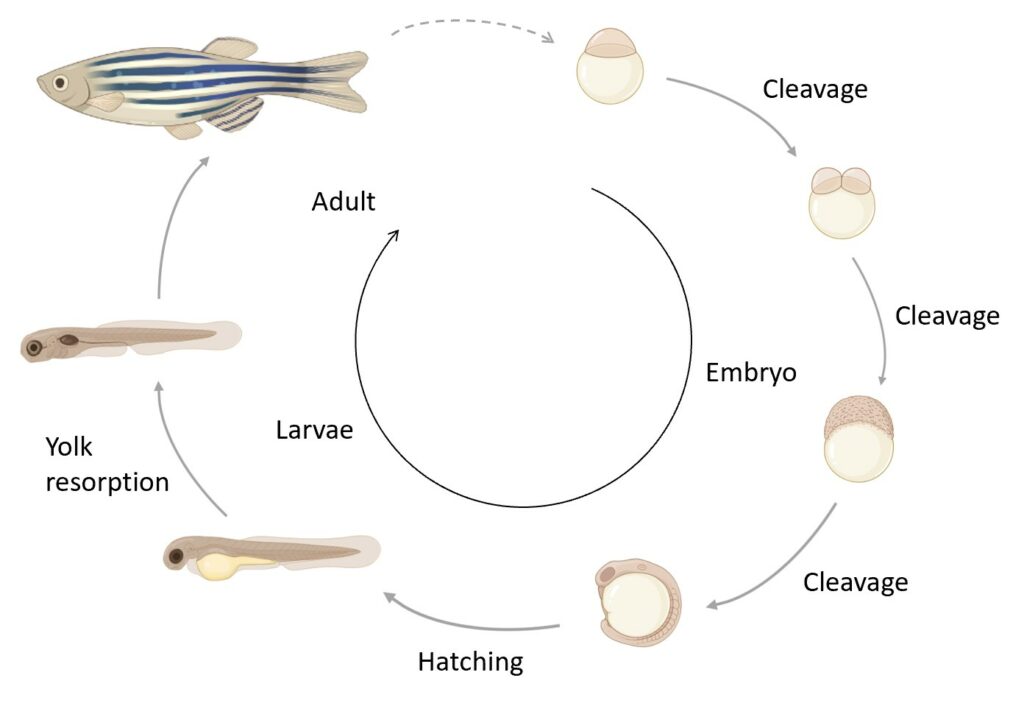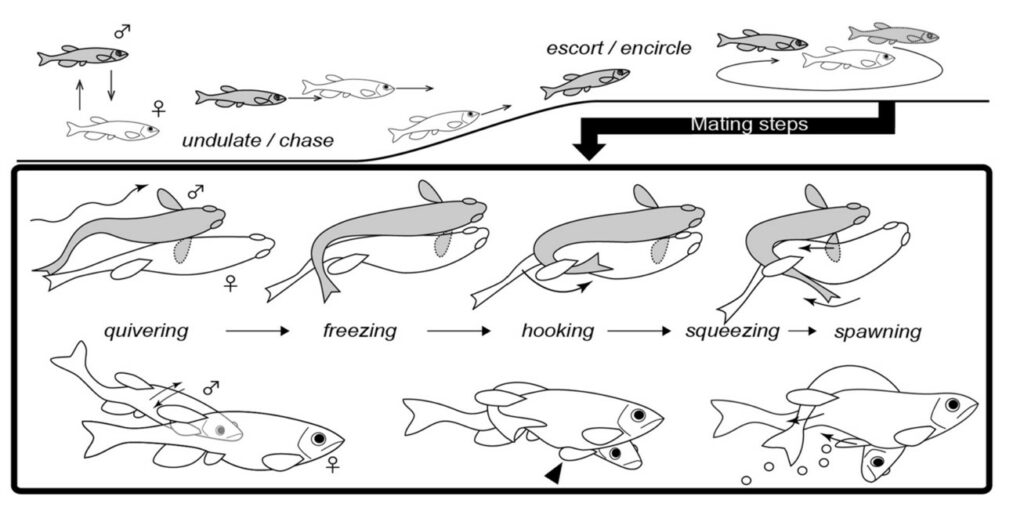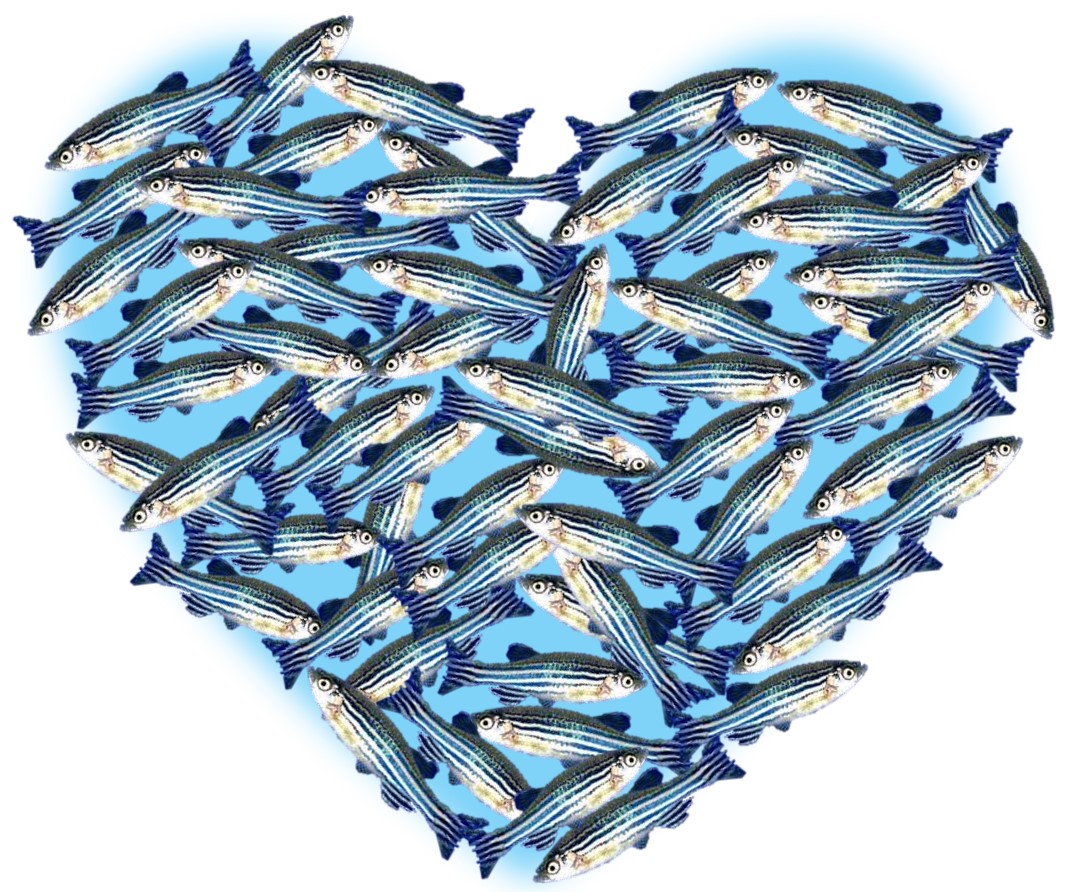Valentine’s Day just passed and zebrafish show us their dance again. In fact, male zebrafish have a special way to seduce females: they court females by dancing!
By being an emergent model in biology and medicine, zebrafish are more and more studied and used. But do we really know about their social behavior?
This article tries to better understand zebrafish breeding and mating choice in order to increase egg production in fish facilities and laboratories.
Zebrafish and its life cycle
Zebrafish is a freshwater fish used as a model organism in laboratories (1). They are used because they are easy to feed and breed, they have a short generation time, their eggs are transparent and until 120 hours post-fertilization, they are not protected by the European Union Directive on the protection of animals in research (2).
Eggs are widely used in research and their quality is very important for the validity of the experiment. Hundreds of eggs are laid at the same time and a sorting is needed to select the fertilized and viable ones. A hand sorting of the eggs is very long and errors can be numerous. Using a device like the EggSorter for the automatic screening, sorting and dispensing of the eggs reduces errors and saves time.
Once eggs are fertilized, cleavage appears to increase the cell number. After three days, the hatching occurs (3), and at this point, the larvae have a 3.5 mm total body length (3). In the following days, the larvae grow and the yolk is resorbed. From this moment, the larvae start to feed. The juvenile stage is then reached at day 30 (3), and three months after the fertilization (3), zebrafish will become adults, with a minimum of 14 mm body length and sexual dimorphism. It is at this moment that spawning behaviors begin (4).

Mating choice
The mating behavior is a competition between males and females to choose the best partner for reproduction. This choice is based on three parameters: olfactory cues, visual stimuli and social interactions (5).
- Olfactory cues are pheromones released both by male and female (6). Pheromones are chemical substances released into the environment to induce particular behaviors in individuals of the same species (7).
Pheromones released by males stimulate female ovulation (5,6).
After ovulation, females release pheromones to induce courtship behavior in males and suppress other females’ fecundity (4–6).
In this sense, olfactory cues are necessary to synchronize mating behavior. Besides, olfactory cues also have the role to avoid mating with kin individuals. Females prefer pheromones of unrelated males rather than pheromones from relatives. In fact, this is necessary to prevent inbreeding which reduces fertility and increases the mortality rate (5).
- Visual stimuli include morphological features. Studies have shown that females prefer larger males (5,6). And in fact, morphology is closely related to dominance too.
- Dominance hierarchies are social interactions where larger males are dominant and are aggressive toward subordinates. Dominant males have greater reproductive success than subordinate males (5). Dominant females do not have more success but they monopolise spawnings with dominant males (5).
As a fact, female zebrafish couple with different males in the same spawning session (5).
The courtship
Once the mating choice is done, the courtship begins. Zebrafish courtship is initiated by the male and is a sequential series of steps: undulate, chase, escort, encircle and then quivering and freezing, wrap around and finally spawning (8). But let’s go one by one:
- Undulate is swimming together for tens of minutes (8).
- The chase consists in the follow of the female by the male (8).
- Then the male escorts the female to the spawning site by swimming between the female and the shallow areas (8).
- The courtship continues with the encircle that is the swim in circles and with the quivering where the male oscillates his body close to the female (8).
- In response to quivering, the female twists her trunk and this step is the freezing (8).
- The wrap around, also called grasping, is when the male trunk enfolds the female (8). This step can be separated in two periods. First, the hooking where the male contorts his trunk in the way to wrap it around the female’s trunk. During this step, the male is allowed to apply a pressure with his trunk and pectoral fin to the female’s trunk.
In response, the squeezing takes place (8). Squeezing consists in a movement of the female body to give access to the male trunk and pectoral fin along her body (8). - The squeezing induces the spawning that is the moment when females release eggs and male release sperm (8).

The mating behavior lasts for a maximum of 40 minutes (8).
The best environmental conditions to promote mating are a depth gradient, regulated light condition (the first hour of sunlight is the busiest for spawning events) and a decrease in water temperature (4,5). And reproduction is most efficient when the fish are between 6 months and a year old (5).
Conclusion
Zebrafish have a complex courtship behavior with a lot of steps identified. In laboratories, it is sometimes difficult to understand why zebrafish don’t produce eggs and a lot of parameters have to be checked. Water quality and composition, stress caused by too much auditory stimuli, a lack of food or the geometry of the aquarium are some of the variables that can influence breeding.
References
- What Are Zebrafish? – Bionomous Bionomous Sàrl [Internet]. [cited 2023 Feb 18]. Available from: https://bionomous.ch/articles/what-are-zebrafish/
- Strähle U, Scholz S, Geisler R, Greiner P, Hollert H, Rastegar S, et al. Zebrafish embryos as an alternative to animal experiments—A commentary on the definition of the onset of protected life stages in animal welfare regulations. Reprod Toxicol. 2012 Apr 1;33(2):128–32.
- ZFIN Zebrafish Developmental Stages [Internet]. [cited 2023 Feb 18]. Available from: https://zfin.org/zf_info/zfbook/stages/
- Sessa AK, White R, Houvras Y, Burke C, Pugach E, Baker B, et al. The Effect of a Depth Gradient on the Mating Behavior, Oviposition Site Preference, and Embryo Production in the Zebrafish, Danio rerio. Zebrafish. 2008 Dec;5(4):335–9.
- Nasiadka A, Clark MD. Zebrafish Breeding in the Laboratory Environment. ILAR J. 2012 Jun 1;53(2):161–8.
- Spence R, Smith C. Mating preference of female zebrafish, Danio rerio, in relation to male dominance. Behav Ecol. 2006 Sep 1;17(5):779–83.
- Larousse É. Définitions : phéromone, phérormone – Dictionnaire de français Larousse [Internet]. [cited 2023 Feb 16]. Available from: https://www.larousse.fr/dictionnaires/francais/ph%C3%A9romone/60232
- Zempo B, Tanaka N, Daikoku E, Ono F. High-speed camera recordings uncover previously unidentified elements of zebrafish mating behaviors integral to successful fertilization. Sci Rep. 2021 Oct 12;11(1):20228.



